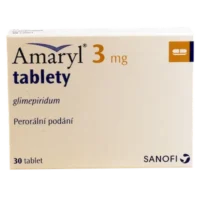Description
Gliutazon Tablets 15 mg. №28
Ingredients:
Each tablet contains 15 mg of Gliutazon.
Mechanism of Action:
Gliutazon works by activating peroxisome proliferator-activated receptors (PPARs) in the body, which are involved in regulating glucose and lipid metabolism.
Pharmacological Properties:
Gliutazon, a thiazolidinedione, improves insulin sensitivity and helps lower blood sugar levels by increasing the body’s response to insulin.
Indications for Use:
Gliutazon tablets are indicated for the treatment of type 2 diabetes mellitus to help control blood glucose levels.
Contraindications:
Avoid using Gliutazon tablets if you have a history of liver disease or heart failure. Consult your healthcare provider before starting this medication.
Side Effects:
Common side effects may include weight gain, edema, and an increased risk of heart failure. Monitor for any signs of adverse effects and report them to your doctor.
Usage Instructions:
The recommended dosage is one tablet daily, to be taken orally with a full glass of water, with or without food. Follow the instructions provided by your healthcare professional.
Benefits Compared to Analogues:
Gliutazon has demonstrated efficacy in improving insulin sensitivity and reducing hemoglobin A1c levels in patients with type 2 diabetes, making it a valuable option in diabetes management.
Suitable Patient Groups:
Gliutazon tablets are suitable for adult patients with type 2 diabetes. Dosage adjustments may be necessary for elderly patients or those with renal impairment.
Storage Conditions and Shelf Life:
Store Gliutazon tablets in a cool, dry place away from direct sunlight. Check the expiration date on the packaging and do not use the product after the specified shelf life.
Packaging Description:
Gliutazon tablets are available in a pack of 28 tablets, each containing 15 mg of the active ingredient. The packaging is designed to ensure the integrity and safety of the tablets.
Clinical Evidence and Proven Effectiveness:
Gliutazon has been studied extensively for its efficacy in managing type 2 diabetes. Research published in the Journal of Clinical Endocrinology & Metabolism has shown that Gliutazon significantly improves insulin sensitivity and reduces hemoglobin A1c levels in diabetic patients.





